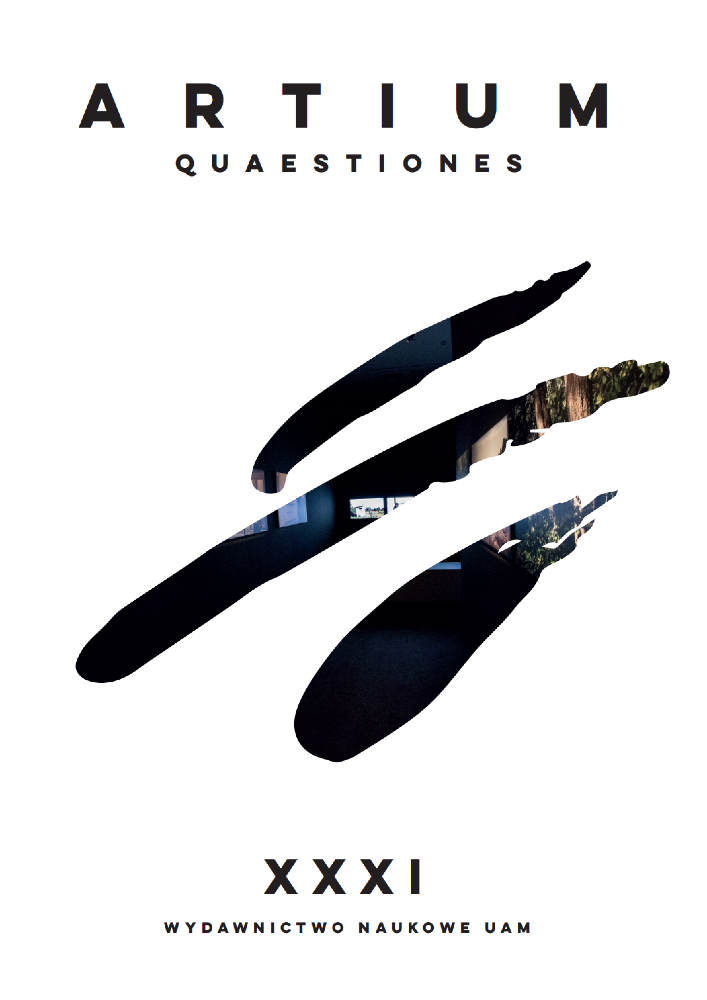Abstract
The article discusses the construction of space and the position of the viewer in the video installation Madame B. Explorations in Emotional Capitalism, presented at the turn of 2013 at the Museum of Art in Łódź. Directed and designed by Mieke Bal and Michelle Williams Gamaker, the installation was produced in parallel with a full feature film of the same title. Both the installation and the film constitute an intersemiotic translation of a literary work – Gustave Flaubert’sMadame Bovary. Part of the inspiration for this experiment was the proto-cinematic quality of Flaubert’s style (narrative simultaneity resembling parallel editing, the suppression of drama, dissolution of the time-flow). The museum installation, with its use of dark exhibition space and multiscreen projection, provided an innovative interpretation of the novel by bringing to the fore its acute audio-visuality: the non-verbal level of meaning found in the presentation of material surroundings, fashion, gesture, facial expressions, sound, tone, and tempo of action. In this respect, the exhibition had an advantage over the continuous version of the feature film, which tends to focus the viewer’s attention more directly on the plot. In the case of the museum installation, the narrative continuity was disregarded in favor of the affective resonance of selected scenes from Emma’s life. Walking through a series of episodes split across nineteen screens, the viewer had to choose his or her own way through a complex narrative (the whole comprised 450 min. of filmic material), so in a sense it was the viewer who “performed the piece”. The narrative of Madame B. partly diverged from Flaubert’s story to bring it closer to our times. The anachronistic intermingling of the 19th century and contemporary realities set it away from the conventions of costume movies and suggested the actuality of Emma’s story – its relevance for contemporary questions of “emotional capitalism”. These anachronisms and the spatialization of the narrative occasioned a specific position for the viewer, who, despite the immersive effect of the images, remained conscious of his or her participatory presence here and now. Thus, while attending to the scenes of Emma’s life, the viewer might also reflect on the emotional effects they raised in him/herself. This analytic outlook did not necessarily inhibit the viewer’s sympathetic engagement with the protagonists’ emotions and experiences, but gave it a more informed character. The spatial arrangement of images, as well as the situations performed in several episodes, also invited reflections on the social function of looking and being seen. In this sense, the installation may be counted as a part of Mieke Bal’s practice of visual culture analysis.
References
Bal M., Reading Rembrandt. Beyond the Word-Image Opposition, Cambridge–New York 1991
Bal M., Krytyka głosu: otwarta partytura twarzy, tłum. G. Grochowski, „Teksty Drugie” 2003, 4(84)
Bal M., Setting the Stage: the Subject Mise en Scène, w: Art of Projection, red. S. Douglas, Ch. Eamon, Stuttgart 2009
Bal M., Czytanie sztuki, przeł. M. Maryl, „Teksty Drugie” 2012, 1–2
Bal M., Madame B.: L’analyse cinématographique d’un roman, „Flaubert. Revue critique et génétique. Traductions/Adaptations” 7 października 2012[, <https://journals.openedition.org/flaubert/1837#text> [dostęp: 19 lutego 2020]
Bal M., Narratologia. Wprowadzenie do teorii narracji, przekład zbiorowy, Kraków 2012
Bal M., Wędrujące pojęcia w naukach humanistycznych, tłum. M. Bucholc, Warszawa 2012
Bal M., Wizualny esencjalizm i przedmiot kultury wizualnej, tłum. M. Bryl, „Artium Quaestiones” 2006, 17
Bal M., Writing with Images. A Conversation with Dorota Filipczak, „Text Matters” 2014, 4(4)
Bal M., Wystawa jako film, tłum. K. Kolenda, w: Display. Strategie wystawiania, red. M. Hussakowska, E.M. Tatar, Kraków 2012
Barthes R., Wychodząc z kina, tłum. Ł. Demby, w: Interpretacja dzieła filmowego. Antologia przekładów, red. W. Godzic, Kraków 1993
Baudry J.-L., Jaskinia Platona, tłum. A. Helman, „Film na Świecie” 1989, 369
Baudry J.-L., Ideologiczne skutki funkcjonowania aparatu, tłum. A. Helman, „Powiększenie” 1995, 1
Bredekamp H., Media obrazowe, tłum. M. Bryl, „Artium Quaestiones” 2004, 15
Donaldson-Evans M., Madame Bovary at the Movies: Adaptation, Ideology, Context, Rodopi 2009
Eisenstein S., Film Form. Essays in Film Theory, red. J. Leyda, New York–London 1977
Emocjonalny kapitalizm a literatura romantyczna – rozmowa Daniela Muzyczuka z Mieke Bal, „Magazyn Szum” 9 lutego 2014
Frank J., Forma przestrzenna w literaturze nowoczesnej, tłum. M. Żurowski, „Przegląd Humanistyczny” 1971, 15
Girard R., Prawda powieściowa i kłamstwo romantyczne, tłum. K. Kot, Warszawa 2001
Glosowitz M., Reprezentować niereprezentowalne. Podmiot, afekt, przedstawienie, w: Kultura afektu – afekty w kulturze. Humanistyka po zwrocie afektywnym, red. A. Dauksza, A. Łebkowska, R. Nycz, Warszawa 2015
Illouz E., Uczucia w dobie kapitalizmu, tłum. Z. Simbierowicz, Warszawa 2010
Krauss R., Reinventing the Medium, „Critical Inquiry” 1999, 25
Krauss R., „A Voyage to the North Sea”. Art in the Age of Post-Medium Condition, London 1999
Melville S., Doświadczenie w latach 60., tłum. M. Salwa, „Sztuka i Filozofia” 2005, 26
Morse M., Video Installation Art: the Body, the Image, and the Space-in-Between, w: Illuminating Video. An Essential Guide to Video Art, red. D. Hall i S.J. Fifer, New York 1990
Rejniak-Majewska A., T. Majewski, Nothing is Missing. Heteroglozje wideo, „Kwartalnik Filmowy” 2012, 80
Screen Dynamics. Mapping the Borders of Cinema, red. G. Koch, V. Pantenburg, S. Rothöhler, Vienna 2012
License
The copyrights are regulated by author's statement and publication agreement prepared by Adam Mickiewicz University Press. The authors are responsible for the originality of texts published and regulating the copyrights of accompanying visual materials, unless the materials come from the Editorial Team.
This work is available with the following licence: Attribution-NonCommercial-NoDerivatives 4.0 International License
Attribution-NonCommercial-NoDerivatives 4.0 International License

